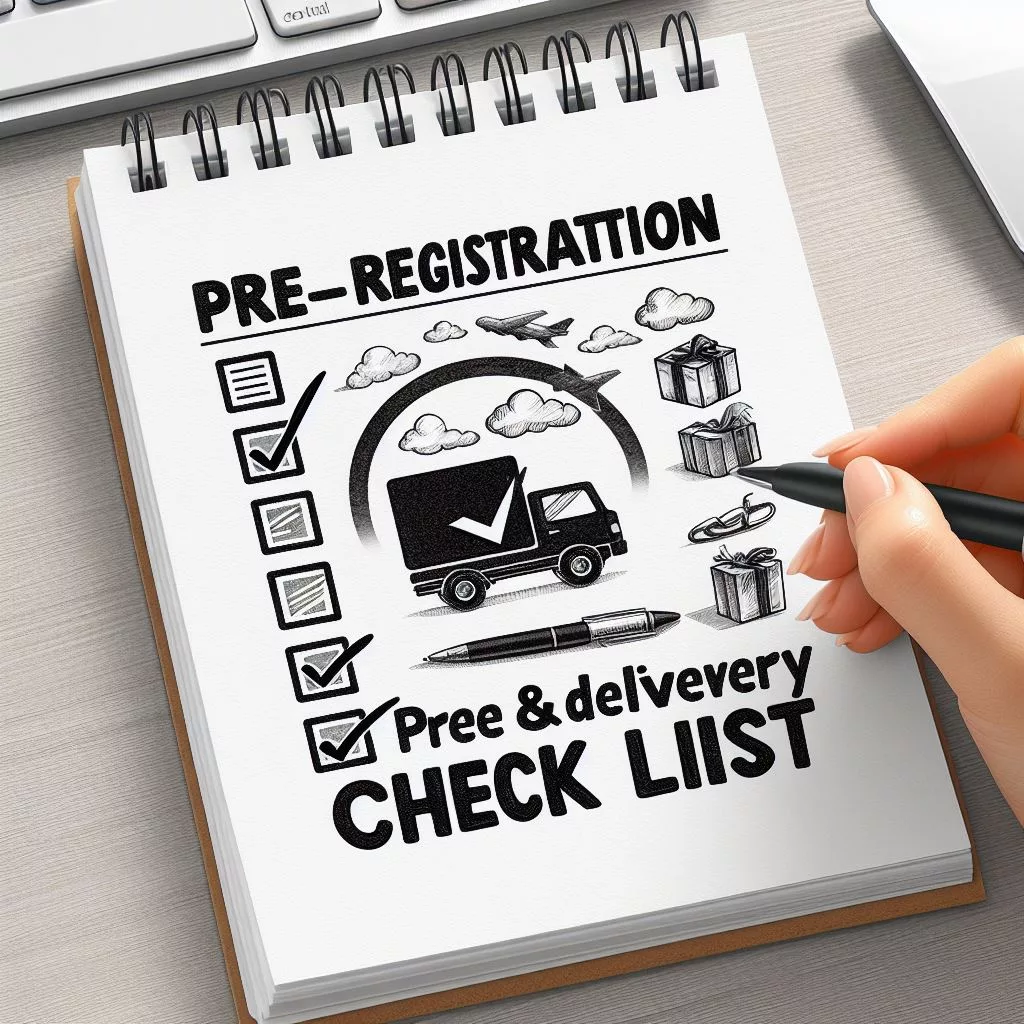Pre-registration & Pre-delivery check list

Once you have decided on the car model that you want to buy, there are a few things that you need to keep in mind before you drive away in it. Ideally, you should have two checks on the vehicle – the pre-registration check and then the pre-delivery check.
Both these checklists consist of the same check points. The idea is to ensure that the car you choose IS the car you drive out of the dealership.
Visit the dealer and check the car prior to registering it in your name. Call the dealer ahead of time and let him know that you plan to perform a very detailed inspection to ensure that the car has been prepared and is ready.
Take a knowledgeable relative or friend along, for suggestions, observations, or comments. Insist that no invoice is made in your name till you complete the inspection. Another check to be done is for any body damage or repair jobs.
Visual Inspection of Vehicle:
Remember, a careful inspection is critical. After the car leaves the dealership lot, the dealer can reasonably claim that any damage or lack has been caused by you. So, take your time on the inspection.
- Do a walk-around on the car – to get a first impression on how clean the car looks.
- Check the car’s manufacturing month/year.
- Check for body damage or repair jobs done, such as difference in paint shade, dents etc…
- Check that the chassis no. and engine no. matches the one mentioned on the invoice or challans.
- Check the mileage on the car – ideally it should be very close to zero. But reasonably, anything less than 50 kms is okay.
- Check to see if seams and door lines are straight. Overuse at the dealership will definitely tell on these parts – they will be worn or dented.
- Engine Check
- Open the bonnet and check if the engine is in perfect shape.
- Check if every dipstick, plastic cover, and wiring is present and properly attached.
- Check that all fluids – transmission fluid, engine oil, coolant, brake oil, power steering oil, windscreen water, and battery water are at optimal level.
- Check for fluid leakage. There should be none. The same applies for dirt or grime.
- Check for signs of exterior wear and tear on engine components. For instance, a spark plug wire that is a different shade of black should be immediately questioned.
- Check the battery – you shouldn’t find any corrosion on the electrodes. It should be properly connected and fastened to wire leads and properly secured.
- Check if the battery has a separate warranty.
- Tyre Check
- Check that the spare wheel is fresh and that all related tools (spanner, jack etc.) are present.
- Are there wheel locks?
- Ensure that the lug key is present in the car.
- What should the proper air pressure be?
- What is the tyre warranty and is it present?
- The tyres should show no signs of wear, and should be properly inflated.
- Tyres should be scuff-free and the hubcaps should be fixed properly.
- Check if all the doors, hoods, trunks, deck lids, and lift gates work properly.
- Do the locks work properly? If they are automatic, can they be operated by remote?
- Make sure that the power window controls, rapid down operation, wipers and rear window defroster are all working properly.
- Carry your own audio cassettes or CDs to test the music system in the car.
- Interior Check – You have the right to expect spic and span interiors
- Check for stains on the carpet, head rest, and seats
- Check if all seatbelts work properly.
- Check if floor mats are all in place.
- Driver’s seat – do you know how to work the seat position controls, such as wheel positioning, tilt, telescope, lock, horn, and cruise control?
- Keys – Ensure that you have more than one set of keys. Check if the remote entry key is working.
- Check for child protection on door locks.
- How does the alarm work? How do you activate and disarm it? Is there a cut off switch?
Documentation:
Read the paperwork properly. DO NOT take anybody’s word for anything. Make sure all the blanks in the contract are filled in. Your paperwork should include:
- Sales certificate
- All payment receipts
- Registration certificate (RC) or temporary registration certificate
- Is your name spelt correctly?
- Is the number same on the number plate and the RC book?
- Check if insurance is adequate, valid, and active.
- Check for original pollution under control (PUC) certificate. This should be valid for one year.
- Owner’s manual.
- Warranty card for car – check to see if warranty details are properly counter-signed by the dealership.
- Check to ensure that you have all the free service coupons in place.
- Ensure that you collect the warranty cards for batteries, tyres, and all other accessories.
- Check extended warranty details (if opted for).
- Check roadside assistance contact details.
- Collect dealership and service personnel business cards
Payment: If any payment formalities still remain to be completed, carry along the relevant post-dated checks (PDCs) or cash or credit card.
Date of delivery: If you have a preference for a particular day / time (for auspicious reasons), inform the dealer well in advance. Always take delivery in broad daylight, since artificial lighting or insufficient lighting at night can be misleading.
Payment: If any payment formalities still remain to be completed, carry along the relevant post-dated checks (PDCs) or cash or credit card.
Date of delivery: If you have a preference for a particular day / time (for auspicious reasons), inform the dealer well in advance. Always take delivery in broad daylight, since artificial lighting or insufficient lighting at night can be misleading.








